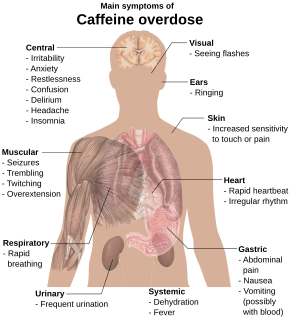Caffeinism
| Caffeinism | |
|---|---|
| Other names | Caffeine overdose |
| Specialty | Toxicology, psychiatry, neurology |
Caffeinism is a state of intoxication caused by excessive consumption of caffeine. This intoxication covers a variety of unpleasant physical and mental symptoms associated with the consumption of excessive amounts of caffeine.[1]
Caffeine is considered one of the most widely consumed drugs around the world. Around 80% of the world population consumes caffeine in one form or another.
Caffeine is also an ingredient of several medications, many of them over-the-counter and prescription drugs. The consensus is to consider caffeine a drug with pharmacological effects acting throughout the body.
Signs and symptoms

In moderate doses, caffeine is used to reduce physical fatigue, to prevent drowsiness and sleep, and to maintain and restore mental alertness and wakefulness. However, at higher doses, these stimulatory effects can become excessive and lead to a wide range of unpleasant symptoms including a dysphoric physical and mental state that is labeled caffeinism and is also known colloquially as "coffee nerves" or "caffeine jitters." These symptoms including nervousness, irritability, restlessness, insomnia, headaches, and palpitations after caffeine use.[4]
Caffeinism usually occurs when consumption of caffeine reaches 1–1.5 grams (0.035–0.053 oz) per day.[5] For reference, a brewed 8oz (227ml) cup of coffee contains ~95 mg of caffeine (per USDA).[6]
According to the
The signs and symptoms are divided into one group that can appear after an intake of as little as 100 mg of caffeine (roughly the amount contained in a cup of brewed coffee) and another group of symptoms that appear at higher levels of intake (more than 1 g per day). Low-dose symptoms include
- restlessness,
- nervousness,
- excitement,
- insomnia,
- flushed face,
- diuresis (increased urination), and
- gastrointestinal disturbance.
Symptoms associated with high doses of caffeine include
- muscle twitching,
- rambling flow of thought and speech,
- tachycardia and cardiac arrhythmia,
- periods of inexhaustibility, and
- psychomotor agitation,[1]
- anorexia (loss of appetite).
- seizures[8]
- Death[8]
The symptoms of caffeine intoxication are comparable to the symptoms of overdoses of other
Death can occur as a result of caffeine overdose.
Treatment
Treatment of mild caffeine intoxication is directed toward symptom relief; severe intoxication may require peritoneal dialysis, hemodialysis, or hemofiltration.[3] Control of caffeine intake requires awareness of the caffeine content of caffeinated beverages, over-the-counter drugs, and other sources of caffeine in the diet. Such information is not easy to obtain. The content of brewed beverages such as coffee and tea varies greatly based on the method of preparation.[19]
There is no standard value for "a cup of coffee." The caffeine content of cola drinks and most energy drinks can be difficult to determine, because in many cases the labels do not indicate the dose per serving. Caffeine doses in these beverages range from 20 to 30 mg in some soft drinks, up to 350 mg or more in some energy drinks. Although some Internet web sites report caffeine content for beverages, official lists are not available and the number of brands continually grows.[1]
Attempting to abruptly discontinue all consumption of caffeine-containing products from the diet is not usually recommended. The person could suffer from severe symptoms of caffeine withdrawal including headaches, fatigue, and difficulty concentrating. It is recommended that the person reduces caffeine consumption gradually to avoid withdrawal as attempts to suddenly discontinue all caffeine consumption are frequently abandoned due to the severity of the withdrawal symptoms.[1][19]
Epidemiology
Little is known about the prevalence of caffeinism in the general population. Although most people are familiar with the disorder, it probably remains underdiagnosed, because patients are rarely questioned about the use of caffeine.[2]
See also
References
- ^ ISBN 978-3-540-68706-1.
- ^ PMID 16509422.
- ^ a b c "Caffeine (Systemic)". MedlinePlus. 25 May 2000. Archived from the original on 23 February 2007. Retrieved 3 August 2009.
- ISBN 978-0-8493-7102-8. Retrieved 15 January 2014.
- .
- ^ "FoodData Central". ndb.nal.usda.gov. Retrieved 2020-10-02.
- ISBN 978-0-89042-062-1.
- ^ ISSN 1053-8801.
- ^ "Caffeine overdose". MedlinePlus. 4 April 2006. Retrieved 3 August 2009.
- S2CID 11820734.
- PMID 14687776.
- ^ "FDA Consumer Advice on Powdered Pure Caffeine". FDA. Retrieved 20 August 2014.
- doi:10.1002/j.1552-4604.1967.tb00034.x. Archived from the originalon 12 January 2012.
- ^ Murray Carpenter (18 May 2015). "Caffeine powder poses deadly risks". New York Times. Retrieved 18 May 2015.
- PMID 7638557.
- ^ Cheston P, Smith L (11 October 2013). "Man died after overdosing on caffeine mints". The Independent. Retrieved 13 October 2013.
- ^ Prynne M (11 October 2013). "Warning over caffeine sweets after father dies from overdose". The Telegraph. Archived from the original on 11 October 2013. Retrieved 13 October 2013.
- ^ Fricker M (12 October 2013). "John Jackson: Family of dad who died from caffeine overdose after eating MINTS want them removed from sale". Daily Mirror. Retrieved 13 October 2013.
- ^ .
